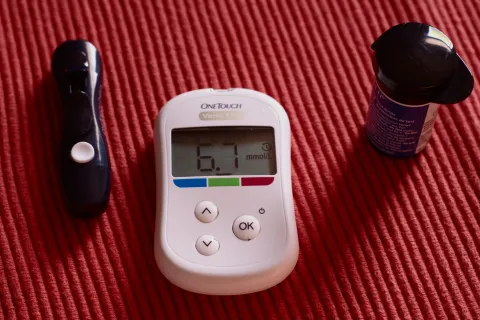Autism and overeating
Adult with autism overeats to self soothe, seeks healthier approach
By Alison Wheeland, OTToday’s “Food for Thought” answer is by occupational therapist Alison Wheeland, a University of Southern California doctoral student completing her residency with Autism Speaks.
This is a question about me. Some of us on the spectrum eat for sensory stimulation or self-soothing. What are some alternate, healthier ways to get that sensory input we crave?
Thank you for bringing up this important aspect of eating for many individuals on the autism spectrum. I suspect there are a great many people who eat to soothe themselves without ever realizing it. Who doesn’t want to drink something hot on a cold day? And many, though not all of us, find it soothing to eat when we’re nervous. Food can be one of life’s great comforts.
As you point out, eating to self-soothe or for sensory stimulation may be particularly common among those with autism. One contributor may be the stress and anxiety that often accompanies autism spectrum disorder (ASD). When this is the case, it’s important for the individual to seek counseling or therapy to find better ways to deal with the underlying cause of the anxiety.
But clearly, not all sensory eating is related to anxiety. You may be craving a particular flavor, a certain texture or even temperature. Sometimes it may not be about the food so much as you just want something to bite down on. Still other times, you may be using food to help stay awake and alert – for instance when you want to focus in school or when driving.
Before I offer my suggestions, I just want to note that I’m not a nutritionist. So please consult an appropriate expert before making any major changes to your diet.
What I can offer is the perspective of an occupational therapist trained in working with sensory issues.
Sensory-focused suggestions for healthier alternatives to overeating:
- Eat and drink slowly. Let the flavor or texture you crave last longer with each bite or sip. You may find you get the sensory stimulation you need while eating less. For instance, one slowly consumed lollipop instead of a gobbled bag of candies. Along the same lines, try drinking a shake or glass of juice through a thin straw so you get only a little at a time.
- Intensify the flavor. Craving something salty? Go for a salty pickle instead of that bag of chips. You’ll satisfy that craving more quickly and with fewer calories.
- Choose healthy, intensely flavored foods. Depending on the sensory hit you’re craving, consider the following:
- Spicy – ginger, fresh or dried peppers, hot sauce or other spicy seasoning, cinnamon gum
- Sweet – fresh bananas, grapes, melon, honey
- Sour – fresh oranges, Granny Smith apples, kiwis, plain yogurt, sour pickles, tomatoes, a squeeze of lemon or lime in water
- Salty – pickles, olives, seaweed, kale chips, unbuttered popcorn, miso soup (Talk with your doctor before overdoing the salt, especially if you may have high blood pressure.)
- Bitter – coffee, tonic water, spinach or kale, unsweetened dark chocolate
- Choose healthier, intensely textured foods. Craving a certain texture in your mouth? How about:
- Creamy – Yogurt (especially Greek yogurt), applesauce, avocado
- Crunchy – kale chips, pickles, carrots
- Bubbly – sparkling water
- Chewy – gum, turkey jerky
- Clear the flavor away. Sometimes, a lingering taste can fuel the craving for more. So after you’ve indulged, drink a glass of water, chew some gum or brush your teeth to clear the leftover flavor from your mouth.
- When it’s the movement you crave. Sometimes a craving to eat is more about the relaxation that comes with moving the muscles in your mouth and jaw. Try some of these strategies:
- Chew a couple pieces of gum at once. Bubble gum blowing gives your mouth a good workout, too.
- Chew on a chewy tube. Often used in occupational and speech therapy, chewy tubes are made of a soft plastic material filled with a thick liquid. It’s a particularly good option for those who have a tendency to swallow gum.
- Play a wind instrument like a recorder, harmonica or flute. (You don’t have to be “good” to enjoy playing in private!
General strategies for stress relief
Perhaps you’re not craving a specific sensation, but simply find eating and drinking to be calming. Try these alternative stress-relief strategies:
If you tend to eat and drink whatever’s at hand when you’re stressed, keep water, unsweetened tea, raw veggies, or sugarless gum handy. Then sip or chew to your heart’s content.
Deep breathing. Put your hand on your stomach and take a slow, deep breath. Feel your stomach expand. When we’re stressed, we tend to take short, shallow breaths. So keep your focus on taking deep breaths and allowing your whole body to relax. The extra oxygen to your brain will also help you think clearly.
Move your muscles. Movement triggers the production of relaxing neurochemicals. This can be as simple as a walk or some yoga stretches or as ambitious as a long run or gym workout. Even at school or work, you can do chair push-ups (push down on the arm rests to lift your bottom off the chair, or just stand up and stretch. Take the stairs instead of the elevator. Just remember to keep breathing deeply.
Listen … to relaxing music, nature sounds or an engrossing podcast or book on tape. You might even enjoy adding this to your breathing or exercise routine.
Take a warm bath or wrap yourself in heavy blankets. Warmth and deep pressure are calming sensations. You can also get deep pressure from a big hug, spandex clothing or even by giving yourself firm squeezes up and down your arms and legs.









